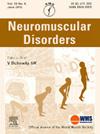Hypokalemic periodic paralysis associated with the atypical CACNA1S c.2690G>A (p.Arg897Lys) variant: description of 14 affected individuals from five families
IF 2.7
4区 医学
Q2 CLINICAL NEUROLOGY
引用次数: 0
Abstract
This study describes five families (14 individuals) with hypokalemic periodic paralysis carrying a heterozygous pathogenic variant NM_000069.3:c.2690G>A (p.Arg897Lys) in the Calcium Voltage-Gated Channel Subunit Alpha1 S (CACNA1S) gene. The clinical exam showed pelvic weakness was common (10/14, with three being too young to exclude this age-dependent myopathy). Electromyography showed myogenic changes, and the long exercise test did not reveal a significant reduction of compound muscle action potential amplitude. Muscle MRI in three patients demonstrated involvement of axial musculature, the pelvic girdle, thighs (with relative sparing of sartorius and gracilis), and legs (especially the gastrocnemius muscles). A homozygosity haplotype analysis in three families revealed a shared segment of approximately 10 million base pairs, suggesting a common ancestor 2-8 generations ago.
低钾性周期性麻痹与非典型CACNA1S c.2690G>A (p.a g897lys)变异相关:来自5个家族的14名受影响个体的描述
本研究描述了携带钙电压门控通道亚单位α 1S (CACNA1S)基因杂合致病变异NM_000069.3:c.2690G> a (p.Arg897Lys)的5个低钾血症性周期性麻痹家族(14个个体)。临床检查显示盆腔无力是常见的(10/14,其中3人太年轻,不能排除这种年龄依赖性肌病)。肌电图显示肌原性改变,长时间运动试验未显示复合肌动作电位幅度明显降低。3例患者的肌肉MRI显示轴肌、骨盆带、大腿(缝阔肌和股薄肌相对较少)和腿(尤其是腓肠肌)受累。通过对三个家族的纯合单倍型分析,发现了大约1000万个碱基对的共享片段,表明在2-8代以前有一个共同的祖先。
本文章由计算机程序翻译,如有差异,请以英文原文为准。
求助全文
约1分钟内获得全文
求助全文
来源期刊

Neuromuscular Disorders
医学-临床神经学
CiteScore
4.60
自引率
3.60%
发文量
543
审稿时长
53 days
期刊介绍:
This international, multidisciplinary journal covers all aspects of neuromuscular disorders in childhood and adult life (including the muscular dystrophies, spinal muscular atrophies, hereditary neuropathies, congenital myopathies, myasthenias, myotonic syndromes, metabolic myopathies and inflammatory myopathies).
The Editors welcome original articles from all areas of the field:
• Clinical aspects, such as new clinical entities, case studies of interest, treatment, management and rehabilitation (including biomechanics, orthotic design and surgery).
• Basic scientific studies of relevance to the clinical syndromes, including advances in the fields of molecular biology and genetics.
• Studies of animal models relevant to the human diseases.
The journal is aimed at a wide range of clinicians, pathologists, associated paramedical professionals and clinical and basic scientists with an interest in the study of neuromuscular disorders.
 求助内容:
求助内容: 应助结果提醒方式:
应助结果提醒方式:


